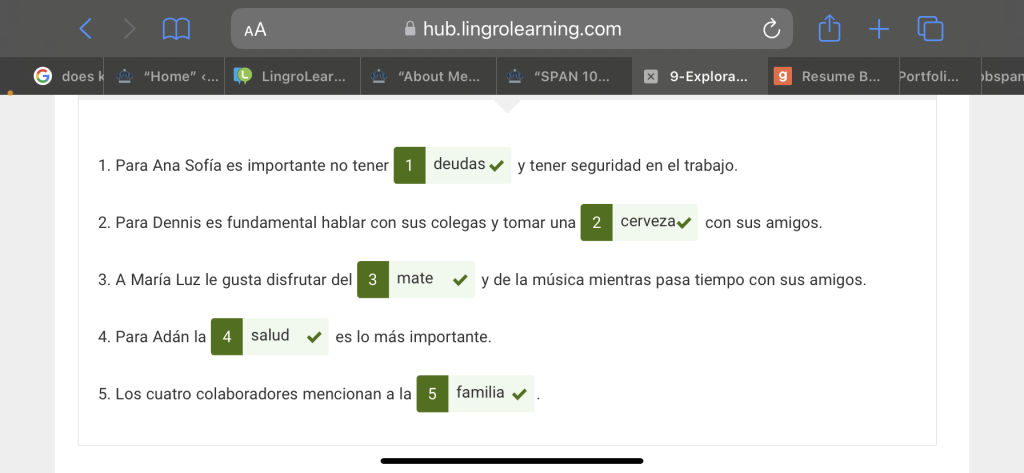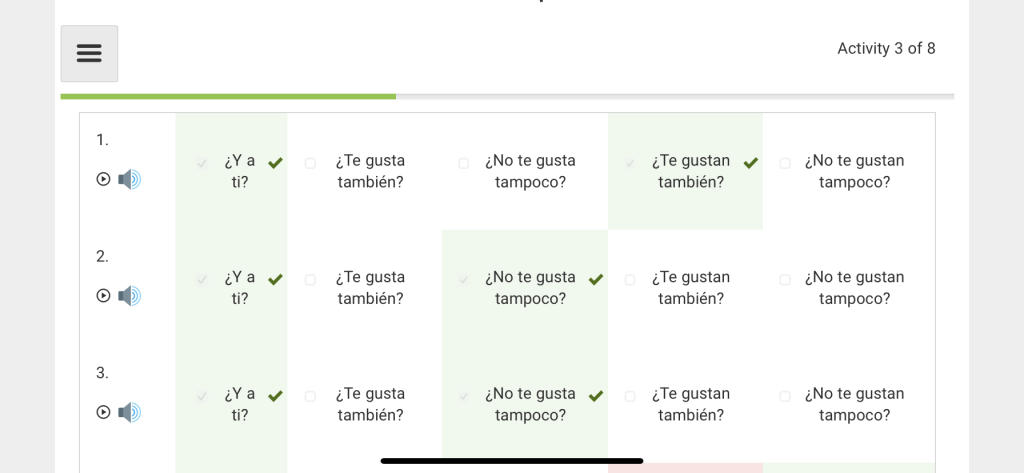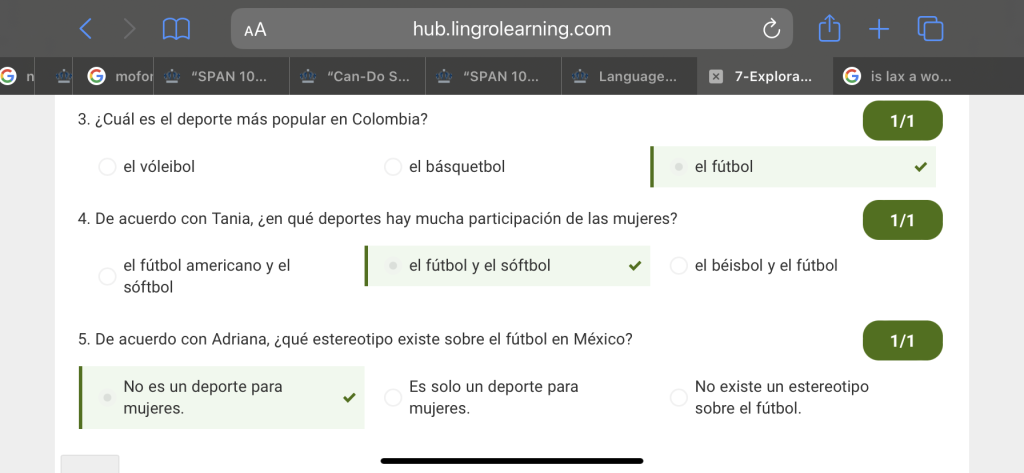Interpretive, Interpersonal, and Presentational Modes of Communication
Instructions
Exploring Culture
Through both Canvas and Lingrohub, I have attainted a greater understanding of how Spanish speaking cultures vary not only from America, but from each other. When it comes to preferred sports, foods, pastimes, LGBTQ+ rights, there is a varied, vibrant, and growingly progressive set of cultures that share the Spanish language.
What these tools really enabled me to grasp is my ignorance to origins of certain policies or behaviors displayed prominently in Hispanic culture, as well as how alike we really are to one another. Lingrohub would put a face, and name to our assignments and readings when exploring the culture, and it really stripped away any alienation in being an English speaker reading purely in Spanish, or the feeling of culture shock in exploring what is the norm elsewhere. This enabled me to have a much easier time with the assignments via creating that human connection, which in turn, prevented any potential judgement unto others that are just different than what I know. Different, certainly in this case, has been eye opening.

Engaging in Communities
Engagement in Spanish speaking communities is paramount to one’s understanding of what those communities are really built around, the people. They create environment that reflects what they feel, love, came from; it becomes the foundation for that communal connection between peoples.
Outside of the classroom, my girlfriend, whom is Puerto Rican, has taken me through the larger patches of Spanish speaking communities throughout Orlando. Indulging in the food trucks, aesthetic, and outdoor games built around people connecting with one another. I believe fundamentally, no group of people are that dissimilar from another, as different acts, foods, games, languages, aim achieve the same goals. I can say with confidence I understand this now better than I ever have.

Interpersonal Communication
Interpersonal communication has taken form in a multitude of ways: interactive recordings, TalkAbroad with native Spanish speakers, and one-on-one conversations with my professor. These different modes of communication encouraged different techniques, preparation and levels of anxiety/excitement that factored into the flow of the conversations, as well as my reflections on them.
Each type of oral assessment created differing levels of stimulation mentally and physically. Prerecorded videos from the professor that needed a response from the student to be complete felt a little more lax; there was room to breathe and think between responses. Though, this stripped away the inherent excitement that was a byproduct of spontaneity that comes with the other forms of assessment I faced, an actual conversation. Of course there was a good bit of effort from the fluent speaker to not overwhelm with advanced vocabulary or thorough topic exploration, but it was nerve-racking nonetheless. The abundance of insecurity about my accent, and flow with the language would make me physically shake, and mentally fatigued. But this was not a reflection of lack of prep, because even through the shakiness and overstimulation mentally, I knew I could do it. Where I would have maybe skipped out and accepted the 0, I knew the value in the experience. I chose to hyper fixate on the principle that what we fear, is what need to face, and when we do, we are better off for it. The more I did it, even as the shakiness remains and my mind restlessly races with anxiety, I got better at it. A big thanks to my professor for her consistent reassurance and dedication to making us feel safe as students.
Presentational Speaking
In presentational speaking there was indeed wildly less pressure. In having the space to breathe, think, and most importantly, start over and try again, was immensely beneficial in practicing without pressure. An example of this was during our FlipGrid conversation.
Within the FlipGrid conversation, I felt challenged by just speaking aloud. There was an expectation in my head, and one I projected into the professors head. All that did was hinder what could have been a smoother completion of the assignment. Having said that, it was exciting, fulfilling and imperative to my growth as a Spanish speaker. I knew more than enough, the issue was easing my mind enough to recall what was in there. In having the room for error, I was able to rehearse phrases, verb conjugations and vocabulary, to begin to make them second nature linguistically. It also helped being able to see everyone else’s videos; we were all in the same boat, and seeing people confident enough to post there videos, made me feel safe to post mine.
FlipGrid link:
Interpretive Listening
Anything revolving around mindful listening to Spanish speakers always made me happy. In hearing how the language ought to flow, where inflection falls, the accent, I felt it was equally important to understand how Spanish should sound (depends on the region of course), as it was to speak it myself.
Through Lingrohub, as well as the FlipGrid conversation, there was space to replay and listen tentatively to what the language sounds like when spoken with certainty and confidence. We listened to a multitude of small recordings related to sports, food, preferences, occupations, and were given questions that tested our mindfulness and comprehension of spoken Spanish. What really helped were the aids: ability to replay the audio, multiple attempts, seeing the words written out to put sounds to the spelling, and no expectation to respond orally, keeping our full attention aimed at understanding the language when heard. They certainly helped my ear during future assessments, as with the added practice of listening, I spent less time trying to consciously hear every word, and began to feel what they were saying.

Interpretive Reading
There was a wide array of readings done throughout the class, via Lingrohub, or discussion boards with a specific subject in mind. These readings had very limited English and required us to use what we knew as context clues to decipher was being discussed. My favorite of these readings included the presence and treatment of the LGTBQ+ community in Hispanics countries.
What really helped me through these readings, regardless of how overwhelmed or unsure I felt about the language was the content within it. There became a desire, almost a need to understand what we being talked about due to my own desire (or need) to understand the world. I care for knowledge, not to feel “intelligent” but to enlighten myself. With these readings touching on universal topics: the love of food, the freedom to choose whom to be with, the rush of athletic competition, the comfort in hobbies or fulfillment through one’s work, you couldn’t help but try your best to understand the language as a means to understand the people. My takeaway is do not let anything stand between you and growing mentally/emotionally/spiritually.
